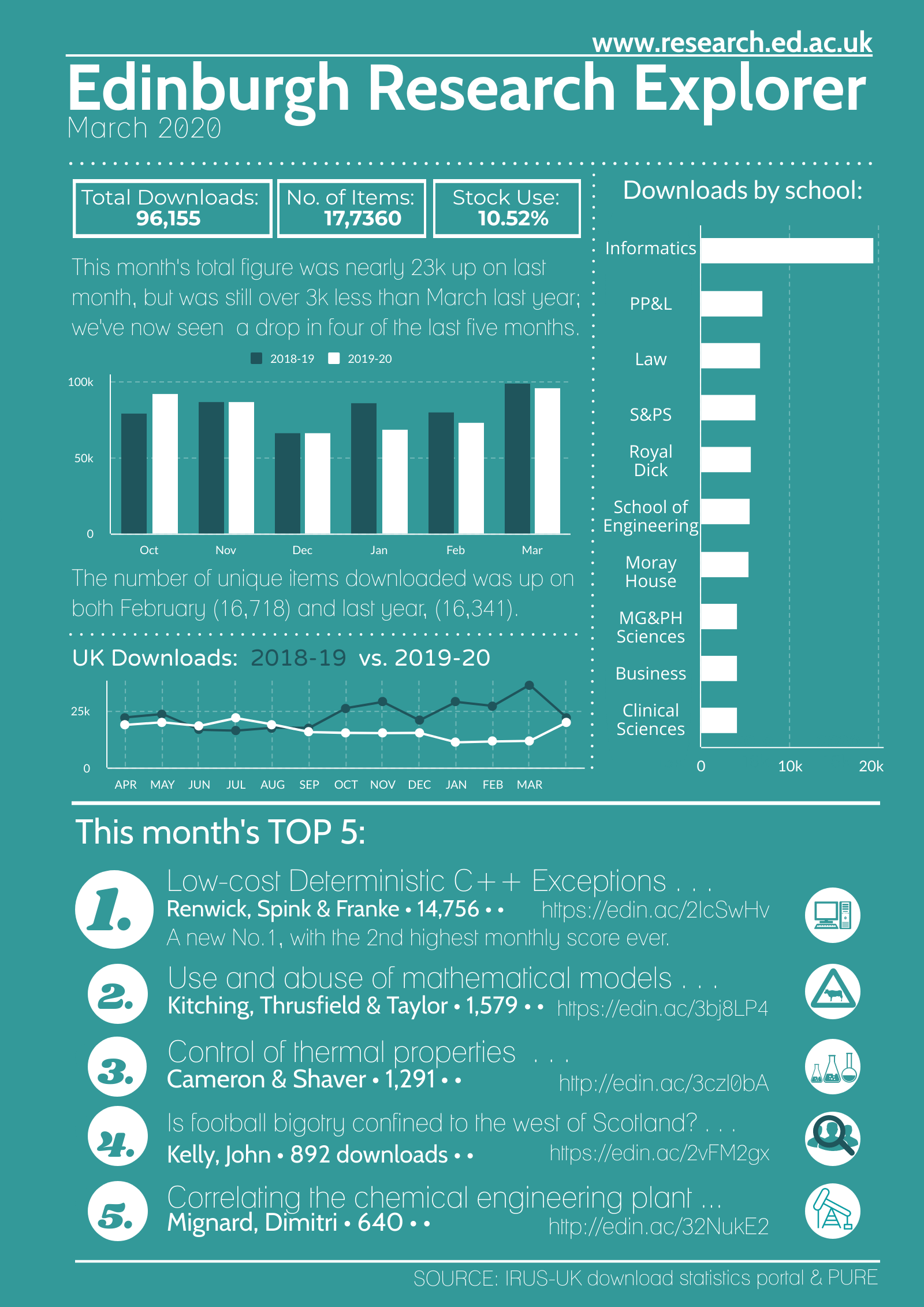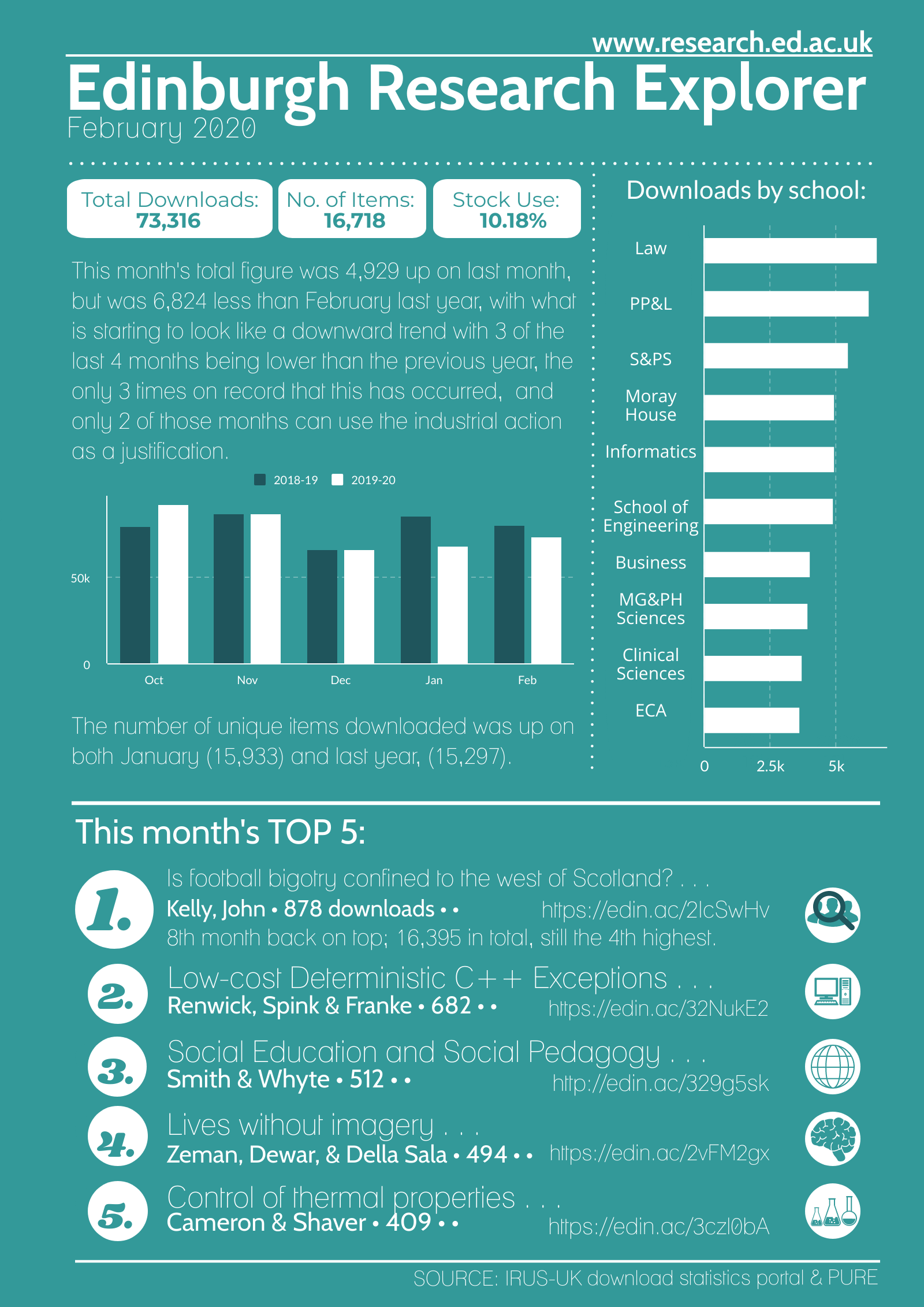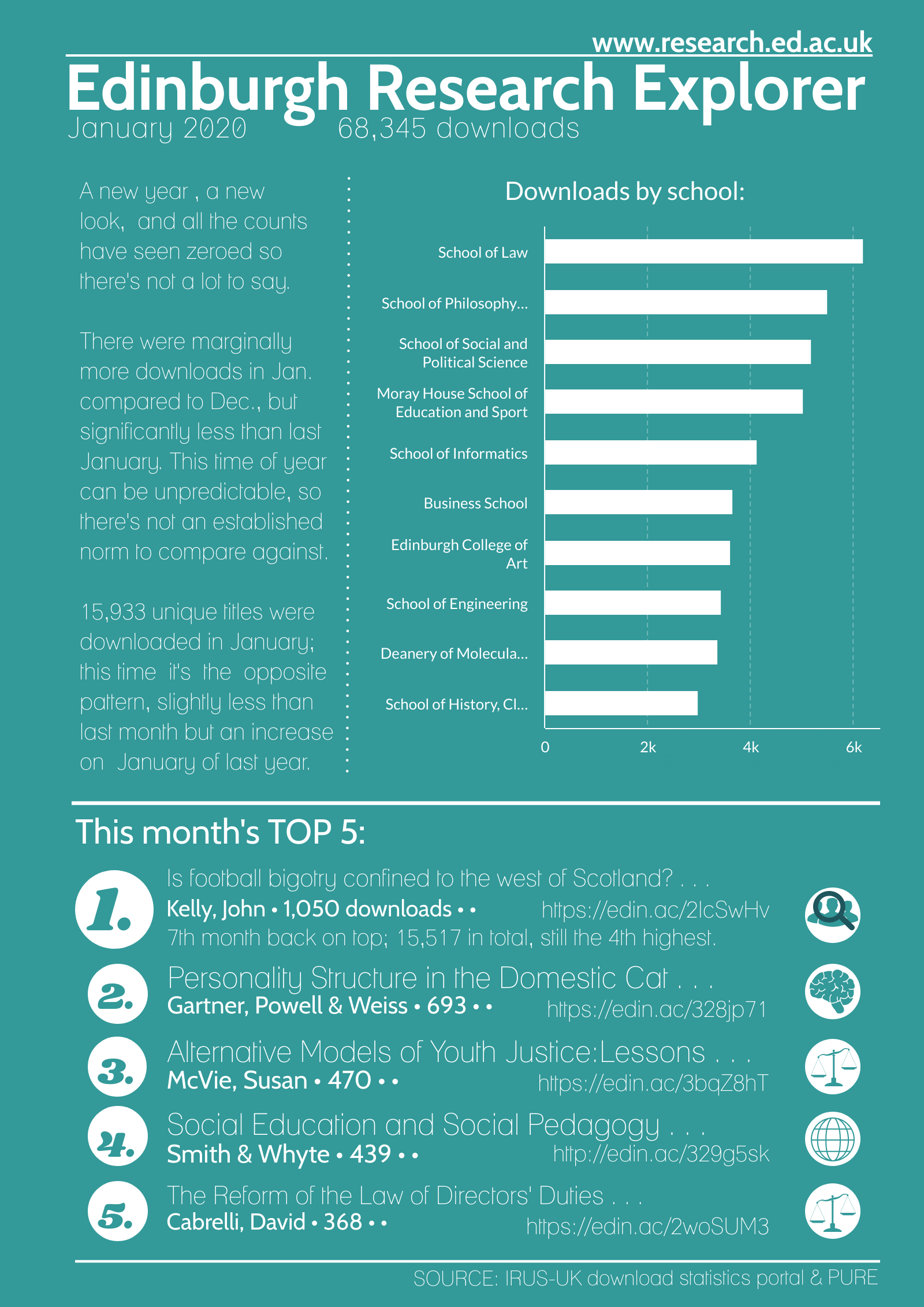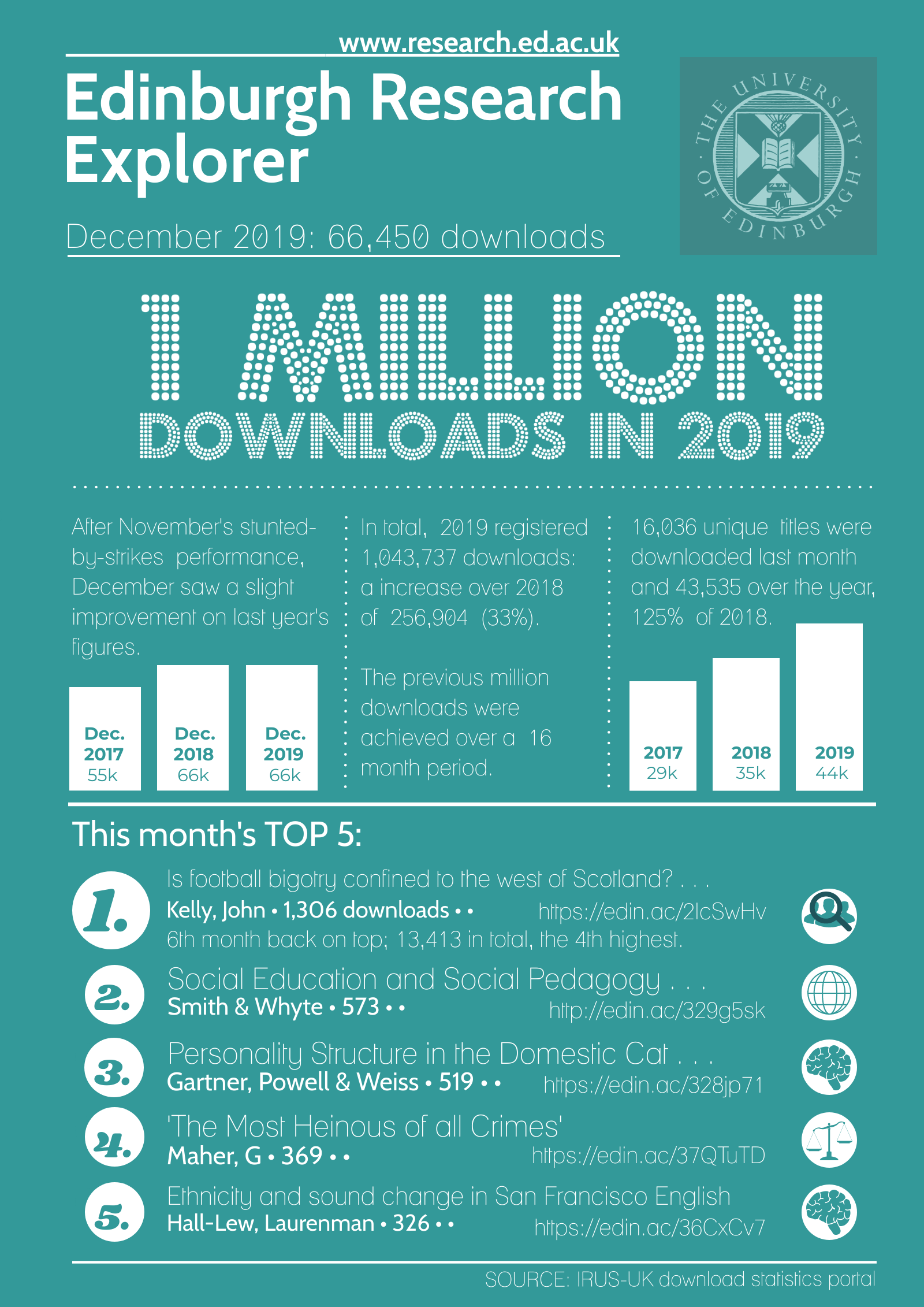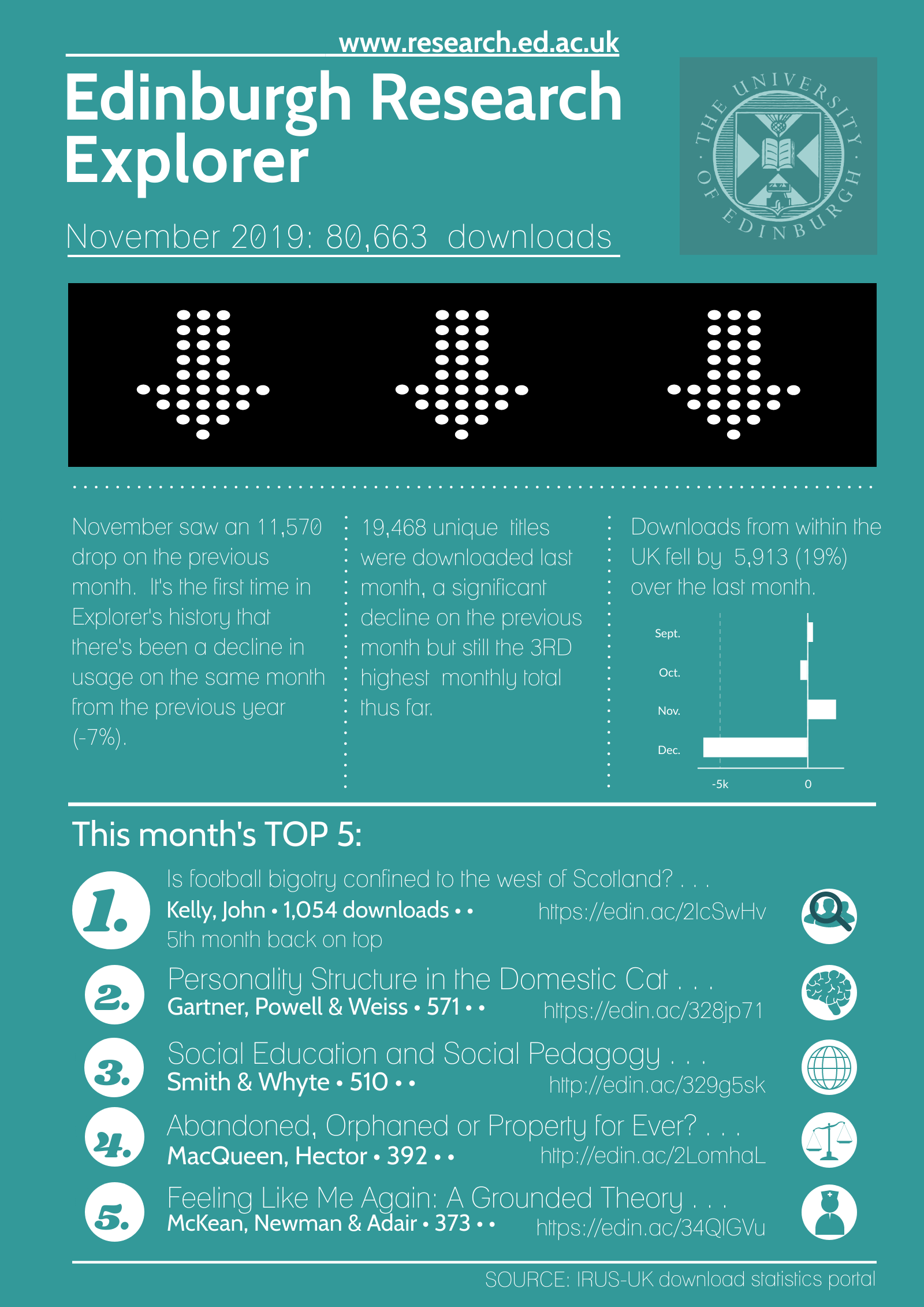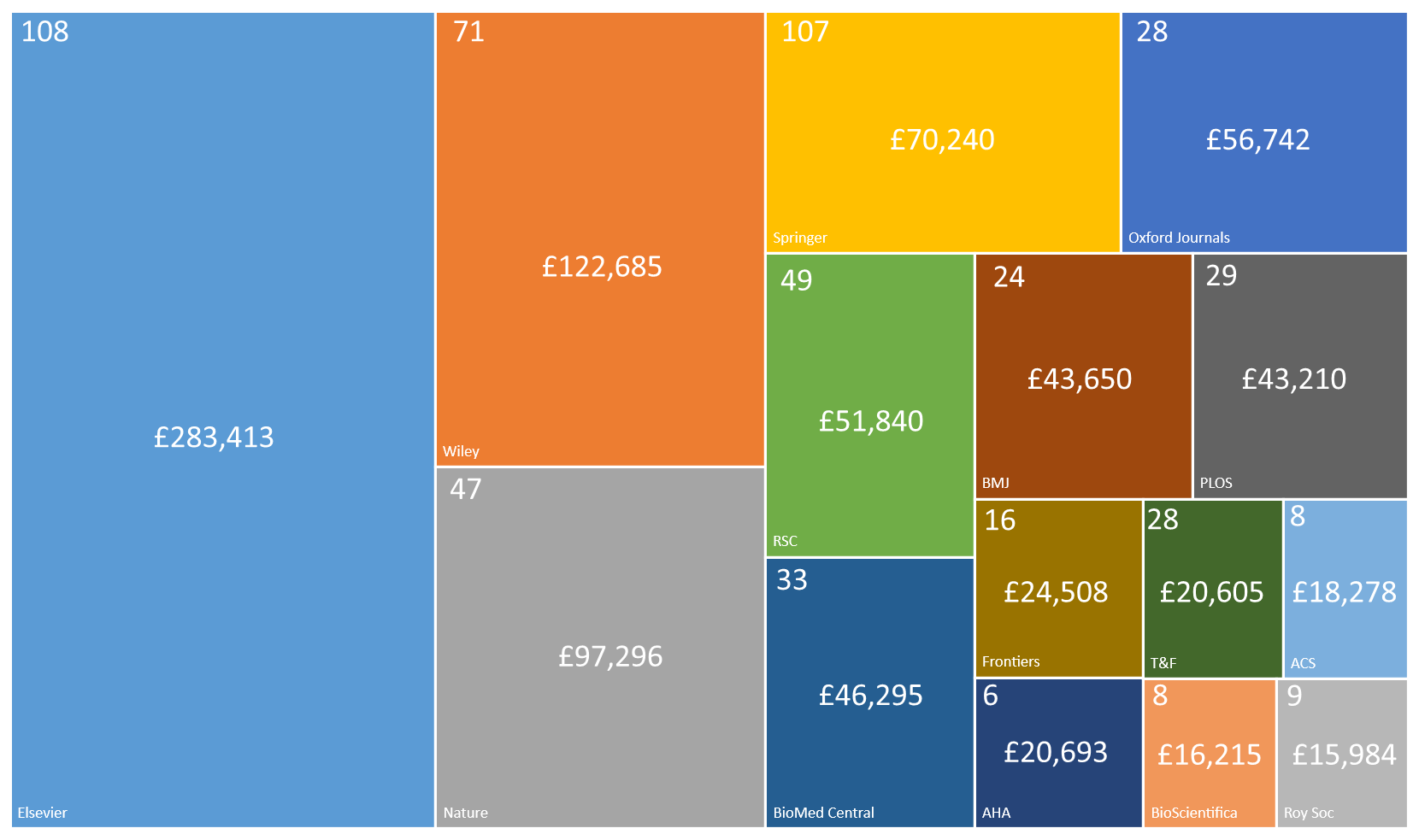Category Archives: Gold OA
Edinburgh Research Explorer Statistics: February 2020
Edinburgh Research Explorer Statistics: January 2020
Edinburgh Research Explorer Statistics: December 2019
Edinburgh Research Explorer Statistics: November 2019
Open Access update
The University of Edinburgh is a strong supporter of open access (OA), and in 2018, researchers at Edinburgh published over 7,000 peer reviewed research outputs, of which over 5,181 (74%) are openly available from the University’s research portal (www.research.ed.ac.uk). As a large and diverse organisation there is naturally a large variation in the way in which we make our research openly available. From our total of 5,181 open access research outputs we find that 2,959 outputs (or 57%) are published as Gold OA – where the publisher makes the version-of-record open sometimes for a fee – and 2,222 (or 43%) are available as Green OA – where the author makes their accepted manuscript open from our Institutional or Subject Repositories for free.
Over the last 5 years the University has spent in the region of £5 million with publishers to make around 2,800 papers Gold OA. The majority of these papers were published as ‘hybrid OA’ in subscription journals where the publisher charges subscription fees to access the closed content, and also charges an open access fee to make individual papers open access. This practice of charging twice is called ‘double-dipping’ as large research intensive institutions have not seen their subscription costs lowered in proportion to their open access expenditure.
Over the last 5 years we have seen a period of significant consolidation of the open access publishing market with just three companies responsible for publishing 51% of Edinburgh’s journal articles, whilst receiving 57% of the money available for open access. The bulk of the University of Edinburgh’s RCUK block grants have been spent on ‘Hybrid OA’ journals as shown in the diagram below. Only 3 out of the 10 most popular publishers are purely Gold OA and don’t charge subscriptions :

Block chart showing the top 10 publishers who received funds from the RCUK open access block grant during 2013-2018. The number in the top left of each box is the total number of Gold OA papers published, the number in the middle of the box is the total expenditure and the name of the publisher is in the bottom left of the box.
Research funders like UKRI and the Wellcome Trust previously supported this ‘hybrid-OA’ model, but they no longer believe that it supports a transition to full OA which is their aim. To precipitate a change in the publisher’s behaviour and to increase the adoption of open access, a number of important European research funders, co-ordinated by Science Europe, developed Plan S.
Plan S update
Plan S requires that, from 2020, scientific publications that result from research funded by public money must be published in compliant Open Access journals, and specifically states that ‘hybrid OA’ journals won’t be supported. As it currently stands, Plan S will be hugely disruptive as researchers will potentially not be able to publish in their journal of choice.
In order to understand the impact of how Plan S will affect our research staff, departments and the broader academic community, Library & University Collections carried out a wide ranging consultation exercise. The Scholarly Communications Team held a series of eight open meetings, during the period 23rd – 30th January 2019, which were attended by over 260 staff. As far as we are aware this was the largest consultation held by a HE institution.
Based on feedback gathered at these meetings, the University has submitted a balance response to that is supportive of Plan S and the time frames set down, but also reflects the concerns raised about risks to international collaboration – specifically co-publishing work with collaborators in non-Plan S regions of the world. The response, and more general information about Plan S, can be read in full on our web pages:
https://www.ed.ac.uk/information-services/research-support/publish-research/open-access/plan-s
UKRI will decide how to apply the principles of Plan S once it has concluded an ongoing review of its own open-access policies, which is not likely to be completed until next autumn. The current Open Access policy is firmly in place until 31st March 2020 and it would be improbable for UKRI to change terms and conditions of grant awards midway through the year. We can therefore expect UKRI to adopt Plan S from 1 April 2020.
3 things we can do to make open access better
Open access is being pulled and pushed in different directions by groups who each have their own intentions and motivations:
- Research funders want to maximize their investment and – by holding the purse-strings – are the change instigators accelerating the pace of adoption of open access. Some are more proactive than others pushing scholarly communication towards Gold OA in certain subject disciplines, whilst other funders are less active preferring change to be more organic.
- Publishers, as gate-keepers of the scholarly written record, influence how open access happens through innovation (developing new business models and products), control of intellectual property (open licensing or imposing journal embargoes) and controlling the spiraling costs. Some publishers are profit-driven and seek the highest returns that the market can burden. Others are more motivated by the academic community
- Libraries are change agents who can help to enable open access in institutions, for example through implementing repository platforms and offering support services and expertise. Their motivations to be involved are many; Library core values are well-aligned with open scholarship, they have a strong interest in and are well-placed to ensure institutional funds are efficiently allocated, and there is a drive to enhance their relevance through redefining roles within research institutions.
- Academics. It is easily to fall in to the trap that academics are passive actors in all of this. It feels like the silent majority go along with the status quo as research is their prime concern, and scholarly communication is a side-show with which they have little interest in how it works. Because publishing is increasingly being outsourced they lack a sense of agency or ownership. However, some researchers are driven to innovate and change their scholarly communication practices.
The interaction of each of these players in the scholarly communication game has led to the development of a system driven by interlocking policies, platforms and processes, which we have shown over the course of the last few blog posts, is unnecessarily complex, expensive, inefficient and increasingly at risk of being not fit for purpose.
What steps should libraries be doing to improve scholarly communication?
1. Remove complexity
The problem with Green OA is – it’s not immediate (journals embargoes are far too long), it’s not compliant with all funders policies and it’s unnecessary complexity (checking and matching funders policies and journal embargoes) is inefficient and has many hidden costs.
Help your institution to adopt the UK-Scholarly Communications Licence and most of these problems are diminished. [Read more here]
2. Reduce OA publishing costs
Hybrid OA Gold is the most popular and expensive route for paid open access. A side effect of lowering embargoes is that authors can comply with their research funders open access policies via Green OA.
Where possible, stop paying Hybrid OA costs, and use the open access block grants for pure Gold OA only. [Read more here]
3. Innovate and nurture academic-led publishing
Academic and National Libraries should support academic-led publishing and open access initiatives that are inclusive and open to scholars who do not have budgets for publishing.
Help your staff and students set up their own open access journals using software like Open Journal Systems. Support initiatives like the Open Library of Humanities by becoming a supporter member, and if you are from a larger institution then you should offer to support at a higher rate. [Read more here]
University of Edinburgh 2016/17 Gold open access spend analysis
The University of Edinburgh receives two main block grants from Research Councils UK (RCUK) and Charity Open Access Fund (COAF) to support researchers funded by them to comply with their open access policies. The Library’s Scholarly Communications Team manages these block grants on behalf of the institution. In 2016/17 we spent £1,167,966 to make 697 articles open access via the Gold open access route. In addition, £28,951 was spent on other publication costs, for example page and colour charges.
A summary of the open access charges made to the top 15 publishers is shown in the table and figures below:
| Row Labels | Count of APC paid | Sum of APC paid (£) | Ave APC (£) |
| Elsevier | 108 | £283,413 | £2,624 |
| Wiley | 71 | £122,685 | £1,728 |
| Nature | 47 | £97,296 | £2,070 |
| Springer | 107 | £70,240 | £656 |
| Oxford Journals | 28 | £56,742 | £2,026 |
| Royal Society of Chemistry | 49 | £51,840 | £1,058 |
| BioMed Central | 33 | £46,295 | £1,403 |
| BMJ Publishing Group Ltd | 24 | £43,650 | £1,819 |
| Public Library of Science | 29 | £43,210 | £1,490 |
| Frontiers | 16 | £24,508 | £1,532 |
| American Heart Association | 6 | £20,693 | £3,449 |
| Taylor & Francis | 28 | £20,605 | £736 |
| American Chemical Society | 8 | £18,278 | £2,285 |
| BioScientifica | 8 | £16,215 | £2,027 |
| Royal Society Publishing | 9 | £15,984 | £1,776 |
Points and trends to note:
- Our overall spend on open access in 2016/17 was £1,167,966 which bought 697 papers, with an average Article Processing Charge (APC) of £1,676.
- The open access expenditure is dominated by three large publishers: Elsevier, SpringerNature and Wiley. These 3 publishers account for 53% of our total spend. Note that we have shown SpringerNature as three individual publishers in the table and figure as they have distinct publishing identities – Springer, Nature and BioMedCentral.
- The top individual publisher (Elsevier) alone accounted for 24% of the total spend, with their APCs 56% more expensive than the average.
- Generally speaking, we found the highest individual APCs were from US society publishers, like the American Heart Association or American Chemical Society.
- Best value APCs were from publishers where we have offsetting or national agreements with – for example Taylor & Francis, Springer and Royal Society of Chemistry.
- 70% of our expenditure is on Hybrid Gold OA – where journals charge a subscription and APCs – rather than pure Gold OA (30%) where APCs are the only charge.
- Looking at the whole dataset Hybrid Gold OA is more expensive (£2,075) than pure Gold OA APCs. (£1,581).
Discussion
The University of Edinburgh publishes 6 -7,000 journal articles and conference proceedings per year. In the current market conditions if we were to fully transition to Gold OA then we estimate it would cost in the region of £10M per year. To put this in context Edinburgh University Library spends approximately £4M per year on e-journal subscriptions so this represents a significant uplift on the total cost of publication. I suspect this figure is similar for other research-intensive universities.
At its current scale and intensity, open access as purely delivered by Hybrid Gold OA and Gold OA alone is not likely to happen. Any increase to the total cost of publication is not acceptable.
If we wish to transition to full open access then significant cost mitigation for paid open access needs to occur, and alternative low cost or no cost options need to be investigated and adopted. Some options are described below.
Reducing cost recommendations
- Push for offsetting deals : Libraries should be a) requesting offsetting deals, b) pushing for significant discounts, and c) helping publishers adopt transformative business models.
Examples of publishers offering good offsetting schemes are IOP – where an actual rebate is given depending on Gold OA spend – and SAGE Publishing who globally discount the subscription rate of journals where more than 5% of articles are published as Gold OA. SAGE also offer steep open access discounts of 80% for some members of consortia subscriptions. Taylor & Francis are another publisher which significantly reduce APC cost (by 75%) to consortia members. These steep discounts are welcome, but have a fundamental problem in that they rely on privilege. Discounts are not available to all authors as they rely on institutions having a subscription.
Transformative business models such as the UK Springer Compact national agreement, or the Royal Society of Chemistry Read and Publish agreement, are also welcome as they lower transactional barriers for authors to participate in Gold OA. This leads to a greater coverage of open access articles in journal titles, rather than the patchy open access that Hybrid Gold OA delivers. The overall costs are also appreciably lower than the cumulative costs seen with Hybrid Gold OA – look at the difference in our expenditure between Elsevier and Springer for a similar amount of Gold OA articles published.
- Support ‘low cost and no cost’ Gold OA : Academic and National Libraries should support open access initiatives that are inclusive and open to scholars who do not have budgets for publishing.
Gold OA does not necessarily equate to paid open access. Many academic or library-led publishing initiatives do not charge Article Processing Charges as the costs are covered through alternative mechanisms. Some examples of innovative academic or library-led publishing activities are described below.
Edinburgh University Library provides an Open Journal Service which is available free of charge to University of Edinburgh students and academics. It provides a hosting platform for academic and student-led groups to create and publish their own Open Access journal. Currently the service has a portfolio of 16 journals and is looking to grow and develop in the coming year.
The Open Library of Humanities (OLH) is a charitable organisation dedicated to publishing open access scholarship with no author-facing article processing charges. The OLH publishing platform supports academic journals from across the humanities disciplines, as well as hosting its own multidisciplinary journal. The University of Edinburgh has opted to support the Open Library of Humanities at a higher rate than required. This additional support will enable the OLH to continue its growth mission to convert subscription journals to a solid, ongoing, open-access model, with no author-facing charges.
- Reduce reliance on Hybrid Gold OA : Hybrid Gold OA – where journals charge both subscriptions and Article Processing Charges – is too expensive.
Unfortunately, Hybrid Gold OA which accounts for 70% of our expenditure are significantly more expensive than pure Gold OA costs. It is not uncommon to receive invoices of $5,000 for individual APCs. Our open access block grants are supported either directly by taxpayers money (RCUK), or from charitable organisations (COAF), so it is imperative that anyone managing these funds should be seeking best value for money. I would find it very difficult to explain to someone who has raised money for Cancer Research UK the hard way by running the London Marathon that their sponsorship money has only paid for half an APC. Where research funders policies allow we should be seeking to reduce our reliance on Hybrid Gold OA by utilising alternative mechanisms like Green OA, which we will visit in more detail in tomorrow’s blog post.
Managing publisher’s open access memberships with Trello
As more and more publishers have started to offer open access institutional memberships we have started to struggle with the effective management of the various schemes. We are currently signed up to 12 active deals and are scoping half a dozen more. All of the memberships are at different stages of maturity leading to a fairly complex situation if you are trying to stay on top of things.
Currently this work is all carried out by one member of the Scholarly Communications Team; however, we are trying to move towards a more transparent decision making and management process which is available to the whole team and other associated staff members.
After reading an interesting post about the use of Trello within Libraries we decided to try out this project management tool for managing our open access membership schemes. I won’t go into detail about about Trello, as this is covered by the blog post linked above, but I will talk about how we are using the tool for this specific purpose.
Each project you wish to manage with Trello gets assigned it’s own board which you can keep private to an individual or share with a team. In the screenshot above you can see that I have 3 private boards and am sharing 2 boards with the Scholarly Communications Team. Looking in more detail at the OA Prepay membership board (screenshot below) you can see that we have created 4 vertical columns, known as lists, each populated with a number of cards. You can assign tasks to cards, but in this case we have chosen to allocate them to publishers membership deals. If you want to you can even assign cards to be monitored by specific people within the team, but we have not yet opted to do this.
The lists are a way to keep the cards organised – for example each list could represent a workflow step. If you like the ‘Getting Things Done‘ methodology you could have To Do, Doing and Done lists.
When looking at publishers’ open access membership deals there are a number of tasks that need to be carried out which can be arranged into 4 general groups:
- Evaluating the initial offering
- Sign-up procedures
- Day-to-day administration and usage monitoring
- Renewal/ deactivation decision making
We decided to use 4 lists to represent the workflow of moving from evaluating new publisher deals, through completing the sign up procedures and monitoring usage, finishing with renewal/deactivation processes:
Scoping -> Current Memberships <-> Action required ->Dropped memberships
Each new potential open access membership deal would be given a new card (see below for an example). The card is firstly populated with a brief description of the membership. We then add a Label (to enable filtering by publisher), a Checklist of to-do items, and a Due Date when a decision is needed. It is possible to add attachments to the card, for example the offer documents or contracts, but we have decided not to do this. Instead we show the file path where the documents are saved on shared network drives accessible only to the team. We don’t trust giving a third party our business documents in case of a data breach.
Once the checklist items have been worked through, if successful and the membership was activated, the card would move over right to the Current Membership list. If unsuccessful we would place at the bottom of the Scoping list with a sticker indicating this (a big red thumbs down).
Once on the Current memberships list (2) the cards are ordered by dates, with the membership deals that are ending first placed at the top. Any member of the Scholarly Communications Team can then see which deals are active, when the membership runs out, find out details of the deal including costs, sales rep contact details and links to other documentation. This is preferable to having all the membership knowledge retained by one member of the team.
Towards the end of the membership period the cards are moved over to the Action Required list (3) to indicate that a renewal or deactivation decision is needed to be made. If renewed the card is placed back into the Current Memberships list with details updated and the Due Date reset (4). If the renewal is rejected then the card is passed right to the Dropped Membership list (5), with the decision details recorded so they can be revisited at a later date if the renewal is questioned.
In summary, the workflow we present here might not work for every institution however we have found Trello to be a very useful tool to manage the process of managing open access membership schemes within a team setting. It’s main benefits are that it is highly visual and thus easy to use with minimal training, very adaptable to fit different circumstances and the basic version is free.
APCs paid in the wild
As part of the Lessons in Open Access Compliance for Higher Education (LOCH) project we have been looking at the problems of identifying Article Processing Charges (APCs) that the Library is not currently aware of – which we colloquially call ‘APCs paid in the wild’. We have written a short case study that is currently under open review at The Winnower:
Improving estimates of the total cost of publication by recognising ‘APCs paid in the wild’
The take home message from our ‘APCs paid in the wild’ case study can be summarised as:
We estimate that these costs could account for up to 20% extra in the total cost of publication that is not currently being accounted for. This additional cost is important to take into account when institutions are negotiating fair offsetting agreements for open access publishing.
We would welcome any constructive criticism on the work so please have a read and leave an open review so that we can improve the article.

